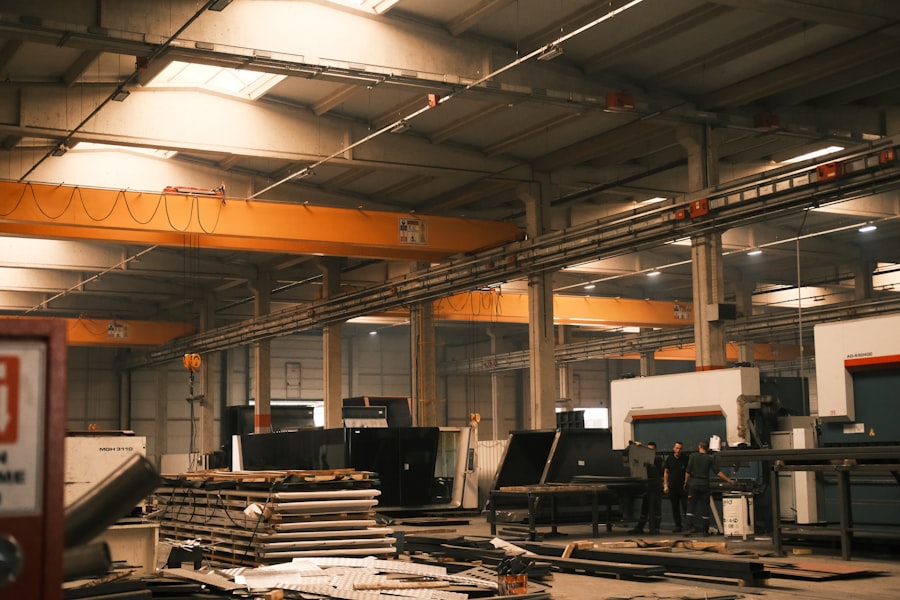The adoption of standing desks has surged in recent years, driven by a growing awareness of the health risks associated with prolonged sitting. Research indicates that excessive sitting can lead to a myriad of health issues, including obesity, cardiovascular disease, and even certain types of cancer. By utilizing a standing desk, individuals can significantly reduce their sedentary time, which is a crucial step toward improving overall health.
Standing while working encourages better circulation, which can enhance energy levels and productivity throughout the day. This shift in posture not only helps in burning more calories but also promotes a more active lifestyle. Moreover, standing desks can have a positive impact on mental well-being.
Many users report feeling more alert and focused when they are standing compared to sitting. This heightened state of awareness can lead to increased creativity and problem-solving capabilities. Additionally, standing desks can help alleviate some common musculoskeletal issues associated with prolonged sitting, such as lower back pain and neck strain.
By promoting a more dynamic work environment, standing desks can contribute to a healthier work-life balance, ultimately leading to improved job satisfaction and performance.
Key Takeaways
- Standing desks can help improve posture, reduce back pain, and increase energy levels
- Consider factors like height adjustability, stability, and surface area when choosing a standing desk
- Use an anti-fatigue mat and ergonomic accessories to set up your standing desk for maximum comfort
- Incorporate regular movement breaks, such as stretching or walking, into your workday at a standing desk
- Gradually transition to a standing desk and listen to your body to avoid common mistakes and discomfort
Choosing the Right Standing Desk for You
Introduction to Standing Desks
Selecting the ideal standing desk involves considering various factors that cater to individual needs and preferences. One of the primary considerations is the desk’s adjustability. Many standing desks come with electric or manual height adjustment features, allowing users to switch between sitting and standing positions seamlessly.
Key Considerations for Choosing a Standing Desk
This flexibility is essential for accommodating different body types and preferences, as well as for sharing the desk with colleagues or family members. A desk that can be easily adjusted ensures that users can maintain an ergonomic posture regardless of their height. Another critical aspect to consider is the desk’s surface area and design. Depending on the nature of your work, you may require ample space for multiple monitors, documents, or other equipment.
Desk Design and Build Quality
A larger surface area can help prevent clutter and promote organization, which is vital for maintaining focus and productivity. Additionally, the material and build quality of the desk should be evaluated; sturdy construction is essential for stability, especially when using multiple screens or heavy equipment.
Making the Final Decision
Aesthetics also play a role in your choice; a desk that complements your workspace can enhance your overall work environment. By considering these factors, you can find a standing desk that meets your needs, promotes productivity, and provides a comfortable working experience.
Setting Up Your Standing Desk for Maximum Comfort

Once you have chosen the right standing desk, the next step is to set it up for optimal comfort and ergonomics. The height of the desk should be adjusted so that your elbows are at a 90-degree angle when typing, with your wrists straight and hands slightly below elbow level. This positioning helps prevent strain on the wrists and shoulders, which can lead to discomfort over time.
Additionally, the monitor should be positioned at eye level or slightly below to avoid neck strain; the top of the screen should be at or just below eye level, allowing you to maintain a neutral neck position. Footwear also plays a significant role in comfort while using a standing desk. Supportive shoes with cushioning can help reduce fatigue in the feet and legs during long periods of standing.
Some users may benefit from using an anti-fatigue mat, which provides cushioning and support while standing, helping to alleviate pressure on the feet and joints. Furthermore, incorporating elements such as a footrest can encourage subtle movement and shifting of weight, which can enhance comfort and circulation throughout the day.
Incorporating Movement into Your Workday
While standing desks promote a more active work environment, it is essential to incorporate movement into your daily routine actively. Simply standing still for extended periods can lead to discomfort and fatigue. To combat this, consider implementing short breaks every 30 to 60 minutes to stretch or walk around your workspace.
These brief intervals not only help relieve tension but also stimulate blood flow and refresh your mind. Simple stretches targeting the neck, shoulders, and back can be performed discreetly at your desk, providing immediate relief from any stiffness. In addition to scheduled breaks, integrating movement into your workday can take various forms.
For instance, consider using a walking pad or treadmill desk for part of your day; this allows you to engage in light walking while working on tasks that do not require intense concentration. Alternatively, you could opt for standing meetings or collaborative sessions where participants are encouraged to move around rather than remain seated. These practices not only promote physical activity but also foster a more dynamic and engaging work culture.
Tips for Transitioning to a Standing Desk
Transitioning from a traditional sitting desk to a standing desk requires some adjustment, both physically and mentally. It is advisable to ease into this new routine gradually rather than making an abrupt switch to standing all day long. Start by alternating between sitting and standing; for example, you might begin with 30 minutes of standing followed by 30 minutes of sitting.
Over time, you can increase the duration spent standing as your body adapts to the new posture. Listening to your body during this transition is crucial. Pay attention to any signs of discomfort or fatigue; if you experience pain in your feet or legs, it may be necessary to adjust your footwear or invest in an anti-fatigue mat.
Additionally, consider keeping a journal to track how you feel throughout the day as you make this change; this can help identify patterns in your comfort levels and productivity as you adapt to your new workspace.
Avoiding Common Mistakes with a Standing Desk

Proper Ergonomics is Key
One prevalent mistake is neglecting proper ergonomics when setting up the desk. Failing to adjust the height correctly can lead to strain on the back, neck, and wrists. It is essential to take the time to fine-tune your setup according to ergonomic guidelines to ensure that you are not inadvertently causing harm while trying to improve your health.
Avoiding Static Standing
Another mistake is remaining static while standing for too long without incorporating movement or breaks. Standing still for extended periods can lead to discomfort in the legs and feet, counteracting the benefits of using a standing desk.
Incorporating Movement and Breaks
To avoid this issue, establish a routine that includes regular movement breaks and stretches throughout your workday. This practice not only enhances comfort but also contributes to overall productivity by keeping both body and mind engaged.
Standing Desk Accessories to Enhance Productivity
To further enhance the experience of using a standing desk, various accessories can be integrated into your workspace. One popular accessory is an anti-fatigue mat, designed specifically for individuals who stand for long periods. These mats provide cushioning that reduces pressure on the feet and joints while encouraging subtle movements that promote circulation.
By investing in an anti-fatigue mat, users can significantly improve their comfort levels throughout the day. Another valuable accessory is a monitor stand or arm that allows for adjustable positioning of screens. This ensures that monitors are at eye level, promoting better posture and reducing neck strain.
Additionally, cable management solutions can help keep cords organized and out of sight, contributing to a cleaner workspace that minimizes distractions. Other accessories such as ergonomic keyboards and mice can also play a role in enhancing comfort and productivity while using a standing desk.
Maintaining Good Posture and Ergonomics with a Standing Desk
Maintaining good posture while using a standing desk is paramount for preventing discomfort and long-term health issues. Users should strive for an upright posture with shoulders relaxed and back straight; this alignment helps distribute weight evenly across the body and reduces strain on specific muscle groups. It is beneficial to engage core muscles slightly while standing; this engagement supports the spine and promotes stability.
Regularly reassessing your posture throughout the day is essential; it’s easy to slip into poor habits without realizing it. Consider setting reminders or using apps designed to prompt users to check their posture periodically. Additionally, incorporating exercises that strengthen core muscles can provide long-term benefits by enhancing overall stability and support while using a standing desk.
By prioritizing good posture and ergonomics, users can enjoy the full range of benefits that come with transitioning to a standing desk environment.
If you are considering switching to a standing desk for your office, you may also be interested in exploring modern executive office desks. These desks not only offer a sleek and professional look but also provide functionality and comfort for long hours of work. You can find more information on modern executive office desks here.
FAQs
What is a standing desk?
A standing desk is a type of desk that allows the user to work while standing up, rather than sitting in a chair. It is designed to promote better posture and reduce the health risks associated with prolonged sitting.
What are the benefits of using a standing desk?
Using a standing desk can help improve posture, reduce the risk of obesity, lower blood sugar levels, and decrease the likelihood of developing heart disease. It can also help alleviate back and neck pain associated with prolonged sitting.
Are there any drawbacks to using a standing desk?
Some people may experience discomfort or fatigue from standing for long periods of time. It is important to find a balance between sitting and standing throughout the day to avoid overexertion.
Can a standing desk be adjusted for different heights?
Yes, many standing desks are adjustable, allowing users to customize the height to their specific needs. This flexibility makes it easier for multiple users to share the same desk.
Are there different types of standing desks available?
Yes, there are various types of standing desks, including fixed-height desks, adjustable-height desks, and desk converters that can be placed on top of an existing desk to create a standing workspace.


